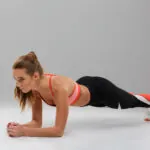Unlike traditional squats, integrating a kettlebell adds a dynamic component that challenges your balance, coordination, and strength. However, as straightforward as kettlebell squats may seem, they come with their own set of nuances that, if overlooked, can significantly hinder effectiveness and even lead to injury. This guide will walk you through the top mistakes to avoid to ensure you’re getting the most out of this potent exercise without risking harm.
Mistake #1: Incorrect foot placement
A common mistake many beginners make is placing their feet incorrectly while performing kettlebell squats. Proper foot alignment is crucial for balance and to effectively engage the right muscle groups.
Ideally, your feet should be shoulder-width apart with toes slightly pointed outward. This position allows for deeper squatting and helps maintain balance. Incorrect foot placement, like having your feet too narrow or too wide, can lead to undue stress on your knees and hips, undermining the squat’s benefits and increasing injury risk.
How to correctly place your feet
To find your ideal stance, start by standing with your feet shoulder-width apart. Pivot your toes out slightly. Practice a few air squats without the kettlebell to ensure comfort and balance.
Pay attention to how your knees move—they should track over your toes without extending past your feet. Once you feel comfortable with your foot placement, introduce the kettlebell.
Mistake #2: Inadequate warm-up
A proper warm-up primes your muscles and joints for the stress of weightlifting and can significantly reduce the risk of injuries. It also enhances your performance by increasing blood flow and flexibility, allowing for a greater range of motion during the squat.
Effective warm-up techniques
A good warm-up for kettlebell squats should include dynamic stretching and light cardio to get your heart rate up.
Consider incorporating leg swings, walking lunges, and some light jogging in place for about 5-10 minutes.
These activities not only prepare your body for the workout ahead but also help you perform the squats more efficiently.
Mistake #3: Improper kettlebell grip
Holding the kettlebell incorrectly can lead to a lack of control and even injury. The grip should be firm yet comfortable, allowing you to control the weight throughout the exercise without straining your wrists.
The correct way to hold a kettlebell
For kettlebell squats, the most common grip is the goblet grip. Hold the kettlebell by the horns with both hands, the bell resting against your chest.
Keep your elbows pointed downward. This grip ensures stability and helps keep your chest lifted and your spine in a neutral position during the squat.
Mistake #4: Rounding the back
Rounding the back during kettlebell squats is a critical error that can lead to severe back injuries. It’s essential to keep your spine neutral throughout the movement.
How to maintain proper back alignment
Focus on engaging your core and keeping your chest up. Imagine pulling your shoulder blades back and down as if you were trying to hold a pencil between them. This posture will help you maintain a strong, straight back as you lower into and rise from the squat.
Mistake #5: Overextending the knees
Allowing your knees to extend too far forward past your toes is a frequent error that can put excessive pressure on your knees. This is especially risky when adding the weight of a kettlebell into the mix.
Knee positioning during squats
To avoid this, make sure your knees stay aligned with your feet as you squat down. Think about sitting back into a chair rather than bending forward from your knees. This adjustment not only protects your knees but also engages the correct muscle groups, like your glutes and hamstrings, enhancing the exercise’s effectiveness.
Mistake #6: Lifting too heavy too soon
This overzealous approach can lead to poor form, muscle strain, or even more serious injuries.
Progressing safely in weight
It’s essential to master the technique with a lighter weight before moving on to heavier kettlebells. Begin with a weight that allows you to perform 10-15 squats comfortably while maintaining proper form. Gradually increase the weight only after you can complete your sets without compromising your stance, depth, or breathing.
Mistake #7: Neglecting core engagement
Ignoring the importance of core engagement in kettlebell squats is a subtle yet significant error. The core stabilizes the torso, protecting the spine and ensuring efficient force transfer between the upper and lower body. If you want to strengthen your lower body further, here are kettlebell exercises targeting the lower back.
Techniques for strong core activation
To properly engage your core, you should actively tighten your abdominal muscles before you start the squat and maintain this contraction throughout the movement. Imagine you are about to be punched in the stomach; this visualization can help you brace your core effectively. This not only improves posture and balance but also maximizes the strength and safety of the squat.
Mistake #8: Inconsistent breathing
Breathing irregularly or holding your breath while performing kettlebell squats can hinder performance and even be dangerous. Proper breathing helps maintain intra-abdominal pressure, which supports the spine during the exercise.
Breathing techniques for better performance
The correct breathing technique involves inhaling as you lower into the squat and exhaling as you push up to stand. This method helps in maintaining intra-abdominal pressure and stability during the lift, providing a natural rhythm that enhances endurance and strength.
If you think your form could be improved for other exercises, the best option is to work with a fitness professional who can guide you through each set.
Final thoughts
Kettlebell squats are an excellent exercise for building strength, enhancing flexibility, and improving overall fitness. However, the effectiveness of this exercise depends significantly on avoiding common mistakes such as improper foot placement, inadequate warm-ups, incorrect grip, and more. By paying close attention to these details, you can maximize the benefits of kettlebell squats while minimizing the risk of injury.





